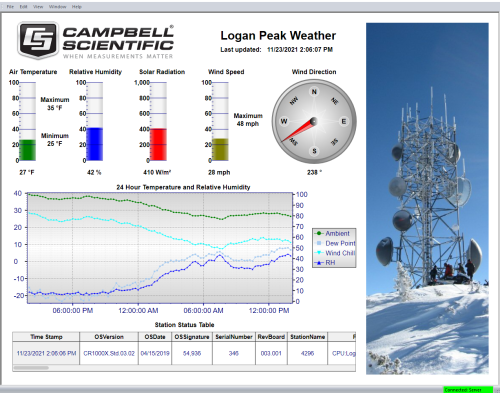
Overview
Current Version: 5.0
RTMC real-time monitoring and control software is bundled with our LoggerNet, LoggerNet Admin, and RTDAQ software. Please note that RTMC cannot be purchased separately. This software graphically displays data, sets input locations, and toggles ports and flags. A simple yet powerful user interface allows RTMC to use components such as alarms, sliders, graphs, toggles, tables, and gauges to design custom multitab displays. For more alarms, switches, graphs, gauges, and layout components, see RTMCPro.
Read More
Benefits and Features
- Real-time monitoring and control software bundled with LoggerNet, LoggerNet Admin, and RTDAQ software
Images

Detailed Description
RTMC Real-time Monitoring and Control Software is bundled with our LoggerNet, LoggerNet Admin, and RTDAQ software. It graphically displays data, sets input locations, and toggles ports and flags. A simple yet powerful user interface allows RTMC to use components such as alarms, sliders, graphs, toggles, tables, and gauges to design custom multi-tab displays.
RTMC's bitmap-based display system provides the tools used to tailor your displays. It can simultaneously display data from any number of data loggers in the network. RTMC can access statistical data reported by the server, including the current state of your data logger network and system-critical information used to trigger alarms. All of RTMC's functions are available when connected as a client to a server on a remote PC. RTMC also includes a sophisticated real-time mathematical compiler for performing real-time calculations. With its point-and-click interface, RTMC is a simple solution for generating real-time displays.
Compatibility
Please note: The following shows notable compatibility information. It is not a comprehensive list of all compatible products.
Dataloggers
| Product | Compatible | Note |
|---|---|---|
| 21X (retired) | ||
| CR10 (retired) | ||
| CR1000 (retired) | ||
| CR1000X (retired) | ||
| CR10X (retired) | RTMC is compatible with the mixed array, PakBus, and TD data logger operating systems for the CR510, CR10X, and CR23X dataloggers. | |
| CR200X (retired) | ||
| CR211X (retired) | ||
| CR216X (retired) | ||
| CR23X (retired) | RTMC is compatible with the mixed array, PakBus, and TD data logger operating systems for the CR510, CR10X, and CR23X dataloggers. | |
| CR300 (retired) | ||
| CR3000 (retired) | ||
| CR310 | ||
| CR350 | ||
| CR500 (retired) | ||
| CR5000 (retired) | ||
| CR510 (retired) | RTMC is compatible with the mixed array, PakBus, and TD data logger operating systems for the CR510, CR10X, and CR23X dataloggers. | |
| CR6 | ||
| CR800 (retired) | ||
| CR850 (retired) | ||
| CR850 (retired) | ||
| CR9000 (retired) | ||
| CR9000X (retired) |
Additional Compatibility Information
Computer
RTMC runs on Windows 10 and 11. RTMC runs on both 32-bit and 64-bit versions of these operating systems.
Specifications
| Current Version | 5.0 |
| Operating System | Windows 11, 10, 8, or 7 (Both 32- and 64-bit operating systems are supported.) |
| Purchased Separately | No (Bundled with LoggerNet, LoggerNet Admin, and RTDAQ software) |
| Software Level | Entry |
| Real-Time Updates | Yes |
| Alarms | Real-time, visual, audible |
Frequently Asked Questions
Number of FAQs related to RTMC: 21
Expand AllCollapse All
-
The project needs to be designed in RTMC Pro using the development environment. The project can then be run within the development environment or by using RTMC Run-Time.
-
In RTMC Pro, add the picture or icon to be used as a hyperlink, and then place a hotspot over it. The HotSpot tool is found in the tool box under Commands.
-
Most controls in RTMC work with mathematical expressions for their fields. For example, if there is a table named one_hour on station stat with a field named temp_degc, an expression can be entered to convert this to degrees Fahrenheit as follows:
1.8 * "stat.one_hour.temp_degc" + 32
-
Value forwarders can be used to keep all of the values synchronized. Use the switch to set the value in one data logger, and then use multiple value forwarders to read this value and forward it on to the other data loggers. The value forwarders can be set as hidden so that they don’t show up in runtime.
-
RTMC can be used to create real-time time-series plots of many parameters.
-
RTMC uses the LoggerNet server for its data source. RTMC Pro, on the other hand, can also use a DAT file.
-
Custom Collection exists solely to collect data directly from the data logger and to write those data to one or more data files. Because of this, the data are not stored permanently in the data cache of LoggerNet. The only way (with RTMC Pro) to get this data into RTMC is to define a data file data source.
-
A network may need to be loaded into LoggerNet from a backup file. If there was no backup, an identical network must be set up in the LoggerNet Setup for the RTMC project to run.
-
Yes, provided the serial sensor is connected to a port that is separate from the one used to connect to LoggerNet.
-
Yes. In RTMC, there is a Value Forwarder component that can be used to read a value from one data logger and send it to another.
Case Studies
In 2022, as Hurricane Fiona unleashed relentless rain on Puerto Rico, the Puerto Rico Landslide......read more
The Department of Science and Innovation (DSI) and its partners, including the Department of Basic......read more
Articles and Press Releases
Privacy Policy Update
We've updated our privacy policy. Learn More





